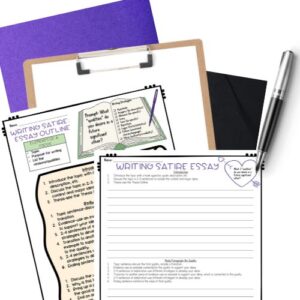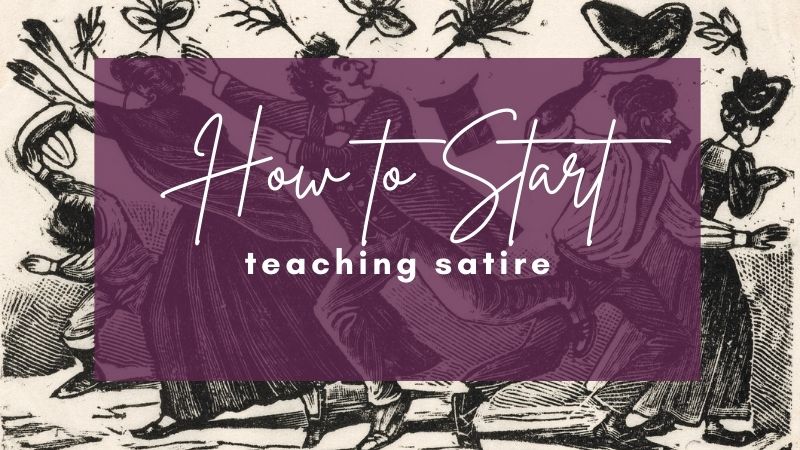Teaching satire is no joke! I know, ha ha! Honestly though, teaching satire can be an amazing journey for a teacher and his/her students. Who doesn’t love watching South Park or The Simpsons? Who doesn’t savor reading “Sending Grandma to the Ovens” by Colin Cohen or the classic “A Modest Proposal” by Jonathan Swift?
I know I love everything satire. I don’t care about the topics or if they offend my personal sensibilities. Good satire is good satire. It provokes. It makes us laugh. It changes us. How to teach satire, however, is another thing altogether!
Here are some things to consider when thinking about teaching satire and how to get your own students to ultimately enjoy and to write their own satires!
Need help with Test Prep? Check out this FREE Pack of 3 Test Prep Activities to help students achieve success on standardized tests!
HOW TO START TEACHING SATIRE
- Start by defining satire: Satire is in a category all by itself. It is not parody. It goes beyond. It seeks to change. Here is my personal definition: Satire is a text that criticizes in order to evoke some sort of change. Without the call for change, it does not fulfill its purpose. So much of what we watch or read is merely parody, an imitation for a laugh. Satire is more than that. We see it around us all of the time.
- Discuss strategies used in satires: Satires notoriously use similar strategies, because they work! In my classroom, I have students focus on these specific strategies and define them before studying satire: hyperbole, irony, tone, repetition, imagery, and the rhetorical appeals. With a firm foundation in these strategies, students will start recognizing them when reading actual satire. Hopefully, this recognition will eventually turn into using these strategies as they write their own satires.
- Provide examples of satire: Students typically need an introduction to satire. I suggest using episodes of Saturday Night Live, The Simpsons, or political cartoons to begin. Teaching satire effectively requires exposure to more commonplace texts; you can’t start with “A Modest Proposal.” Most students will be so overwhelmed with the language and the historical context that they will not fully grasp what Swift is “proposing.” Instead, start with images or videos.
- Read and watch satire with your students: It may take longer than simply assigning a typical short story to read, but reading satire with your students is crucial. Students need to hear you read aloud, think aloud, annotate “aloud,” and respond aloud. Remember, most have seen satire, but few truly understand it as satire. Have fun and choose texts you will laugh at with them. I recommend “The Dam Letters.” Even my most struggling readers love these letters!
- Use SPAUTS or other Graphic Organizers for during and after the reading: (Speaker, Purpose, Audience, Universal Idea, Tone, and Strategies) By using an organizer, your students can focus on the most important elements of satire. While reading, you can help them with filling out the above information. They can use this information to write a response, write a rhetorical analysis, answer comprehension questions, etc. In breaking it down, any student can grow in his or her understanding of satire.
Check out this teaching satire bundle for “A Modest Proposal” and “Sending Grandma to the Ovens!”
Want to read more about teaching satire? Check out 7 Steps to Teaching with High School Satire Essays!
HOW TO TEACH SATIRICAL WRITING
When it comes to bridging the gap between reading satire versus writing satire, students need guidance. I would start by reading both “Sending Grandma to the Ovens” and “A Modest Proposal.” These two texts are similar in structure, purpose, and topic. Your students can model their own essays after teaching satire like these texts. They can even propose something!
Here are some “proposals” they can make:
- How to be a wonderful boyfriend or girlfriend
- How to propose to someone
- How to be a good student
- How to be a productive employee
- How to grow a business
- How to be an amazing parent
- How to be an effective writer
- How to prepare for exams
- How to get a job
- How to create friendships
Click to get a teaching satire bundle with 4 satirical essay prompts and writing activities!
Ultimately, by developing a firm foundation using the strategies above, students can then branch out into writing their own satires. They can use the models you provide and dip their toes into constructing their own satire and effecting change in others around them. And they won’t have to eat a baby to do it!
Check out this Step-By-Step Lesson in helping students write their own satires 🙂

Need more fun lessons and activities for the year? Check out my store Kristin Menke-Integrated ELA Test Prep!




